Organizational Change and Employee Performance: A Dissertation Study
VerifiedAdded on 2020/10/22
|46
|23346
|300
Thesis and Dissertation
AI Summary
This dissertation investigates the impact of organizational change on employee performance within the IT sector, using DXC Technology Malaysia as a case study. The study examines the influence of organizational culture, communication, and commitment on employee efficiency, quality, productivity, and timeliness. The research employs a mixed-methods approach, including a literature review, conceptual framework, and quantitative analysis using statistical tools like SPSS. The study formulates hypotheses to examine the relationships between independent variables (organizational factors) and the dependent variable (employee performance). The findings aim to provide recommendations for improving employee performance during organizational changes, considering factors like technological advancements and the need for skilled employees. The dissertation also addresses the research methodology, including research philosophy, design, approach, and data analysis, along with limitations and recommendations for future research.
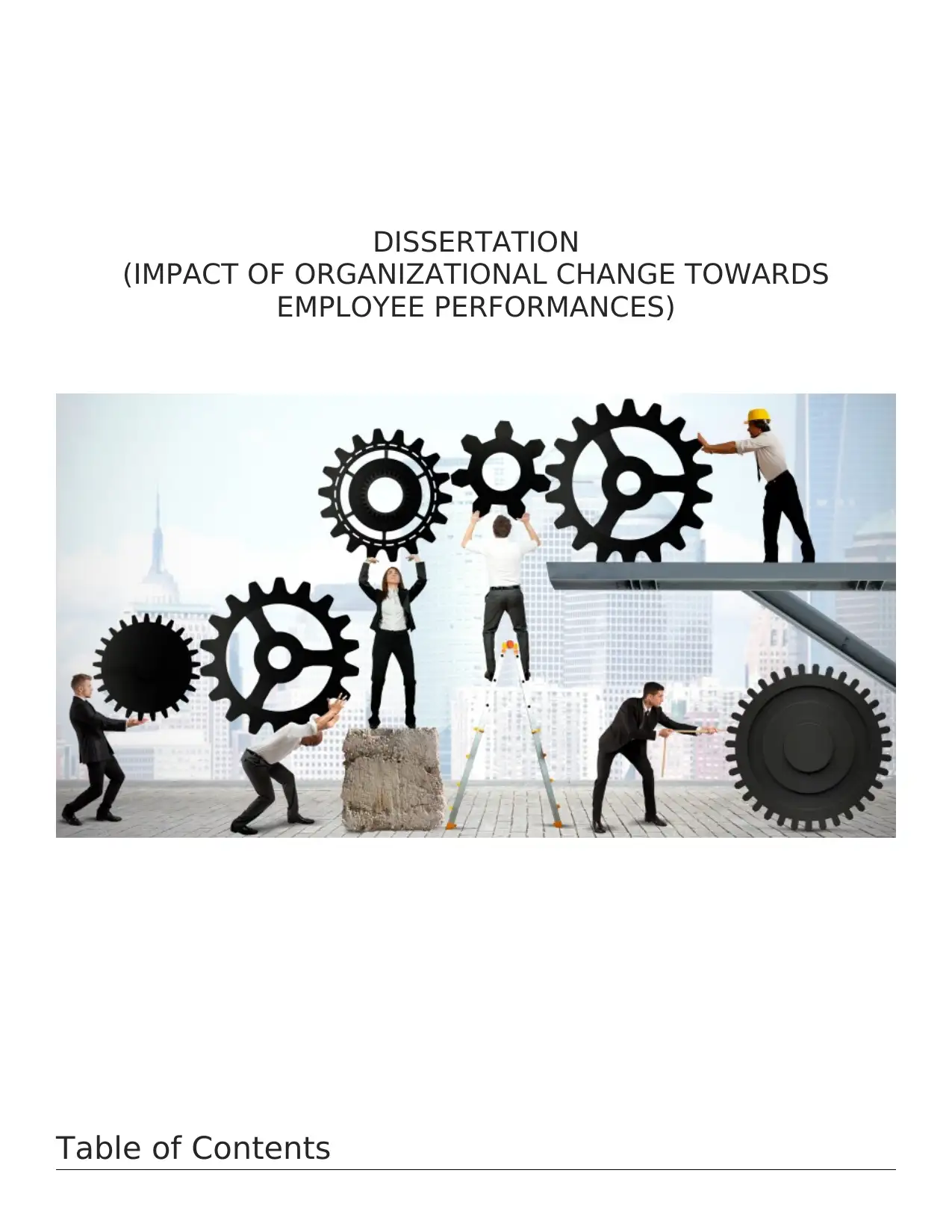
DISSERTATION
(IMPACT OF ORGANIZATIONAL CHANGE TOWARDS
EMPLOYEE PERFORMANCES)
Table of Contents
(IMPACT OF ORGANIZATIONAL CHANGE TOWARDS
EMPLOYEE PERFORMANCES)
Table of Contents
Paraphrase This Document
Need a fresh take? Get an instant paraphrase of this document with our AI Paraphraser
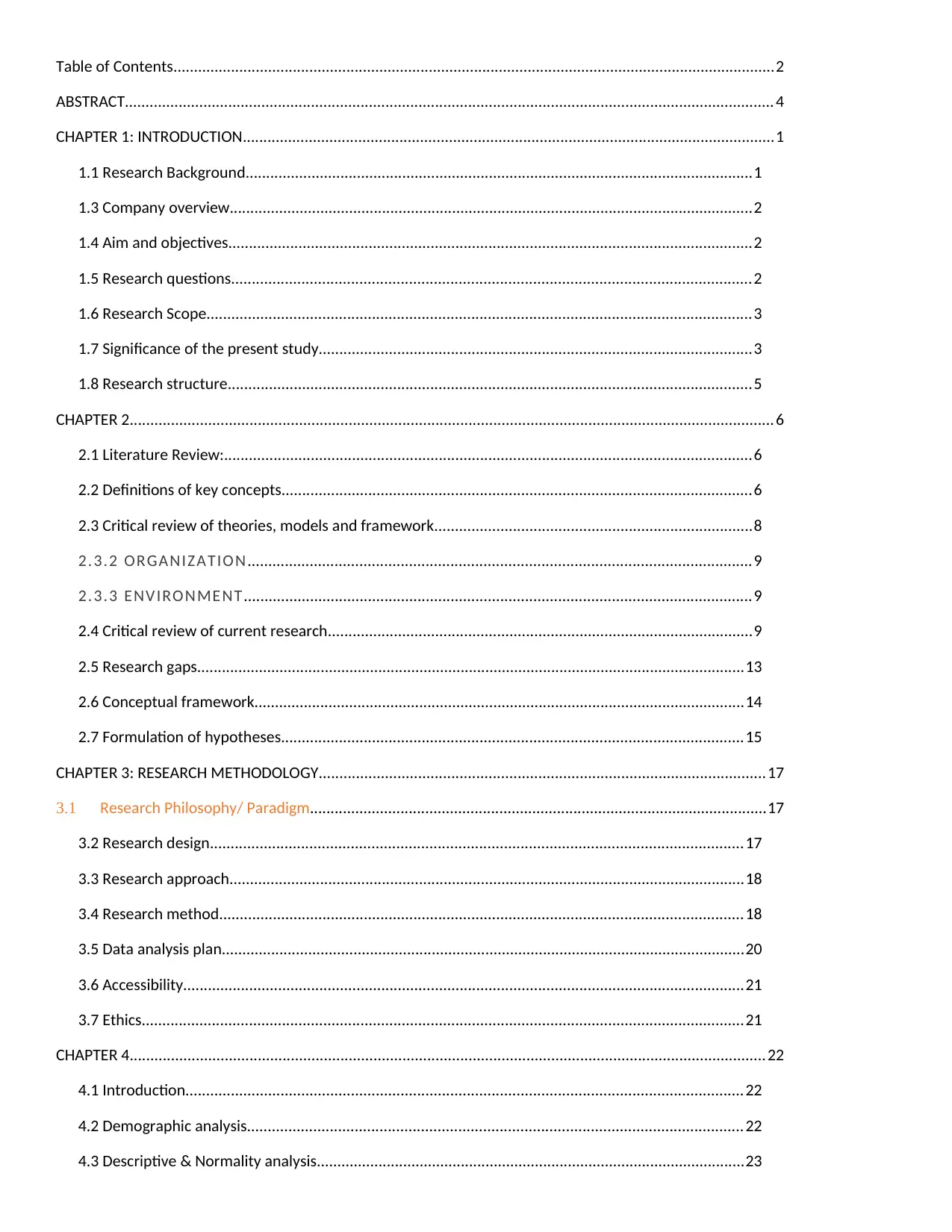
Table of Contents..................................................................................................................................................2
ABSTRACT............................................................................................................................................................. 4
CHAPTER 1: INTRODUCTION.................................................................................................................................1
1.1 Research Background...........................................................................................................................1
1.3 Company overview...............................................................................................................................2
1.4 Aim and objectives...............................................................................................................................2
1.5 Research questions..............................................................................................................................2
1.6 Research Scope....................................................................................................................................3
1.7 Significance of the present study.........................................................................................................3
1.8 Research structure...............................................................................................................................5
CHAPTER 2............................................................................................................................................................ 6
2.1 Literature Review:................................................................................................................................6
2.2 Definitions of key concepts..................................................................................................................6
2.3 Critical review of theories, models and framework.............................................................................8
2.3.2 ORGANIZATION ..........................................................................................................................9
2.3.3 ENVIRONMENT...........................................................................................................................9
2.4 Critical review of current research.......................................................................................................9
2.5 Research gaps.....................................................................................................................................13
2.6 Conceptual framework.......................................................................................................................14
2.7 Formulation of hypotheses................................................................................................................15
CHAPTER 3: RESEARCH METHODOLOGY............................................................................................................17
3.1 Research Philosophy/ Paradigm...............................................................................................................17
3.2 Research design.................................................................................................................................17
3.3 Research approach.............................................................................................................................18
3.4 Research method...............................................................................................................................18
3.5 Data analysis plan...............................................................................................................................20
3.6 Accessibility........................................................................................................................................21
3.7 Ethics..................................................................................................................................................21
CHAPTER 4.......................................................................................................................................................... 22
4.1 Introduction.......................................................................................................................................22
4.2 Demographic analysis........................................................................................................................22
4.3 Descriptive & Normality analysis........................................................................................................23
ABSTRACT............................................................................................................................................................. 4
CHAPTER 1: INTRODUCTION.................................................................................................................................1
1.1 Research Background...........................................................................................................................1
1.3 Company overview...............................................................................................................................2
1.4 Aim and objectives...............................................................................................................................2
1.5 Research questions..............................................................................................................................2
1.6 Research Scope....................................................................................................................................3
1.7 Significance of the present study.........................................................................................................3
1.8 Research structure...............................................................................................................................5
CHAPTER 2............................................................................................................................................................ 6
2.1 Literature Review:................................................................................................................................6
2.2 Definitions of key concepts..................................................................................................................6
2.3 Critical review of theories, models and framework.............................................................................8
2.3.2 ORGANIZATION ..........................................................................................................................9
2.3.3 ENVIRONMENT...........................................................................................................................9
2.4 Critical review of current research.......................................................................................................9
2.5 Research gaps.....................................................................................................................................13
2.6 Conceptual framework.......................................................................................................................14
2.7 Formulation of hypotheses................................................................................................................15
CHAPTER 3: RESEARCH METHODOLOGY............................................................................................................17
3.1 Research Philosophy/ Paradigm...............................................................................................................17
3.2 Research design.................................................................................................................................17
3.3 Research approach.............................................................................................................................18
3.4 Research method...............................................................................................................................18
3.5 Data analysis plan...............................................................................................................................20
3.6 Accessibility........................................................................................................................................21
3.7 Ethics..................................................................................................................................................21
CHAPTER 4.......................................................................................................................................................... 22
4.1 Introduction.......................................................................................................................................22
4.2 Demographic analysis........................................................................................................................22
4.3 Descriptive & Normality analysis........................................................................................................23
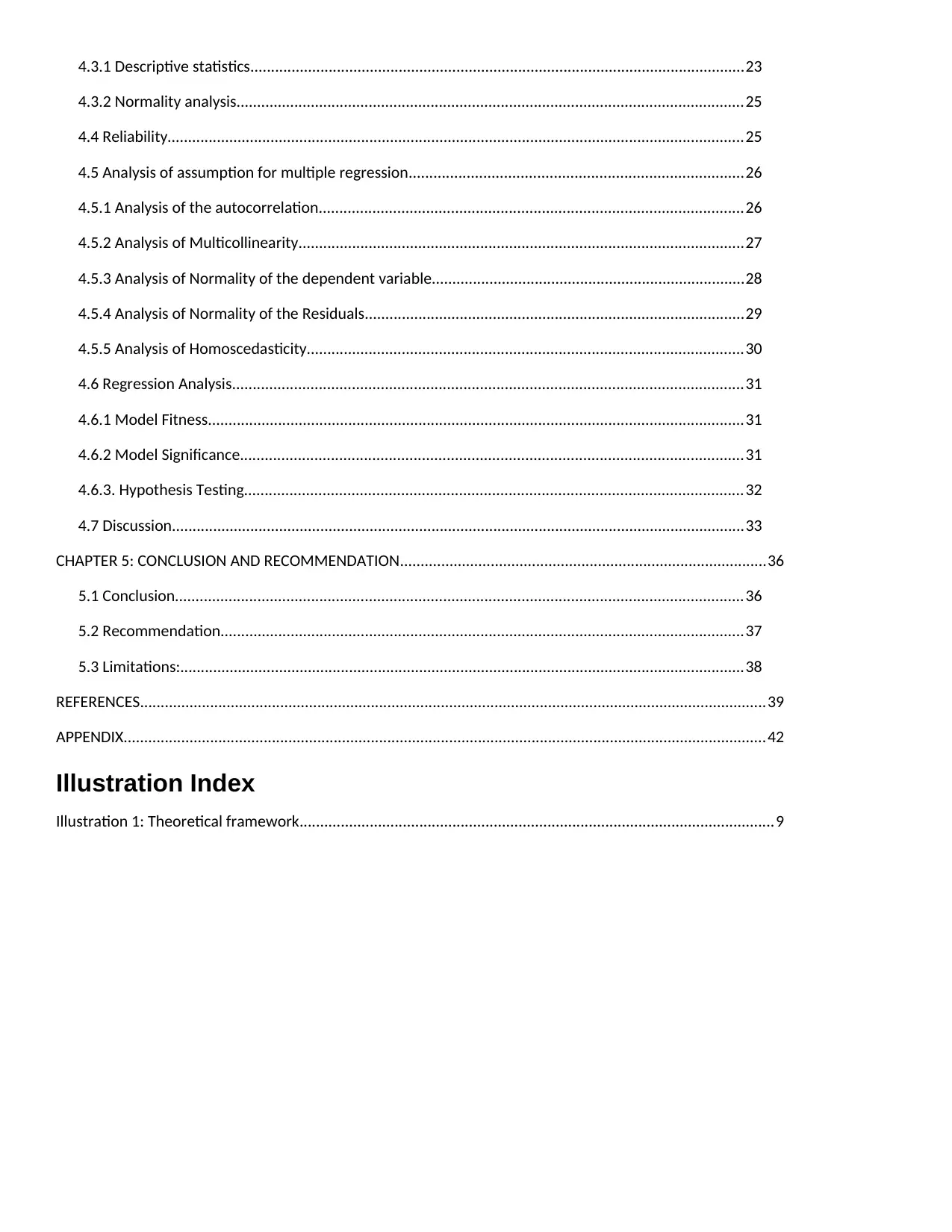
4.3.1 Descriptive statistics........................................................................................................................23
4.3.2 Normality analysis...........................................................................................................................25
4.4 Reliability............................................................................................................................................25
4.5 Analysis of assumption for multiple regression.................................................................................26
4.5.1 Analysis of the autocorrelation.......................................................................................................26
4.5.2 Analysis of Multicollinearity............................................................................................................27
4.5.3 Analysis of Normality of the dependent variable............................................................................28
4.5.4 Analysis of Normality of the Residuals............................................................................................29
4.5.5 Analysis of Homoscedasticity..........................................................................................................30
4.6 Regression Analysis............................................................................................................................31
4.6.1 Model Fitness..................................................................................................................................31
4.6.2 Model Significance..........................................................................................................................31
4.6.3. Hypothesis Testing.........................................................................................................................32
4.7 Discussion...........................................................................................................................................33
CHAPTER 5: CONCLUSION AND RECOMMENDATION.........................................................................................36
5.1 Conclusion..........................................................................................................................................36
5.2 Recommendation...............................................................................................................................37
5.3 Limitations:.........................................................................................................................................38
REFERENCES........................................................................................................................................................39
APPENDIX............................................................................................................................................................42
Illustration Index
Illustration 1: Theoretical framework...................................................................................................................9
4.3.2 Normality analysis...........................................................................................................................25
4.4 Reliability............................................................................................................................................25
4.5 Analysis of assumption for multiple regression.................................................................................26
4.5.1 Analysis of the autocorrelation.......................................................................................................26
4.5.2 Analysis of Multicollinearity............................................................................................................27
4.5.3 Analysis of Normality of the dependent variable............................................................................28
4.5.4 Analysis of Normality of the Residuals............................................................................................29
4.5.5 Analysis of Homoscedasticity..........................................................................................................30
4.6 Regression Analysis............................................................................................................................31
4.6.1 Model Fitness..................................................................................................................................31
4.6.2 Model Significance..........................................................................................................................31
4.6.3. Hypothesis Testing.........................................................................................................................32
4.7 Discussion...........................................................................................................................................33
CHAPTER 5: CONCLUSION AND RECOMMENDATION.........................................................................................36
5.1 Conclusion..........................................................................................................................................36
5.2 Recommendation...............................................................................................................................37
5.3 Limitations:.........................................................................................................................................38
REFERENCES........................................................................................................................................................39
APPENDIX............................................................................................................................................................42
Illustration Index
Illustration 1: Theoretical framework...................................................................................................................9
⊘ This is a preview!⊘
Do you want full access?
Subscribe today to unlock all pages.

Trusted by 1+ million students worldwide
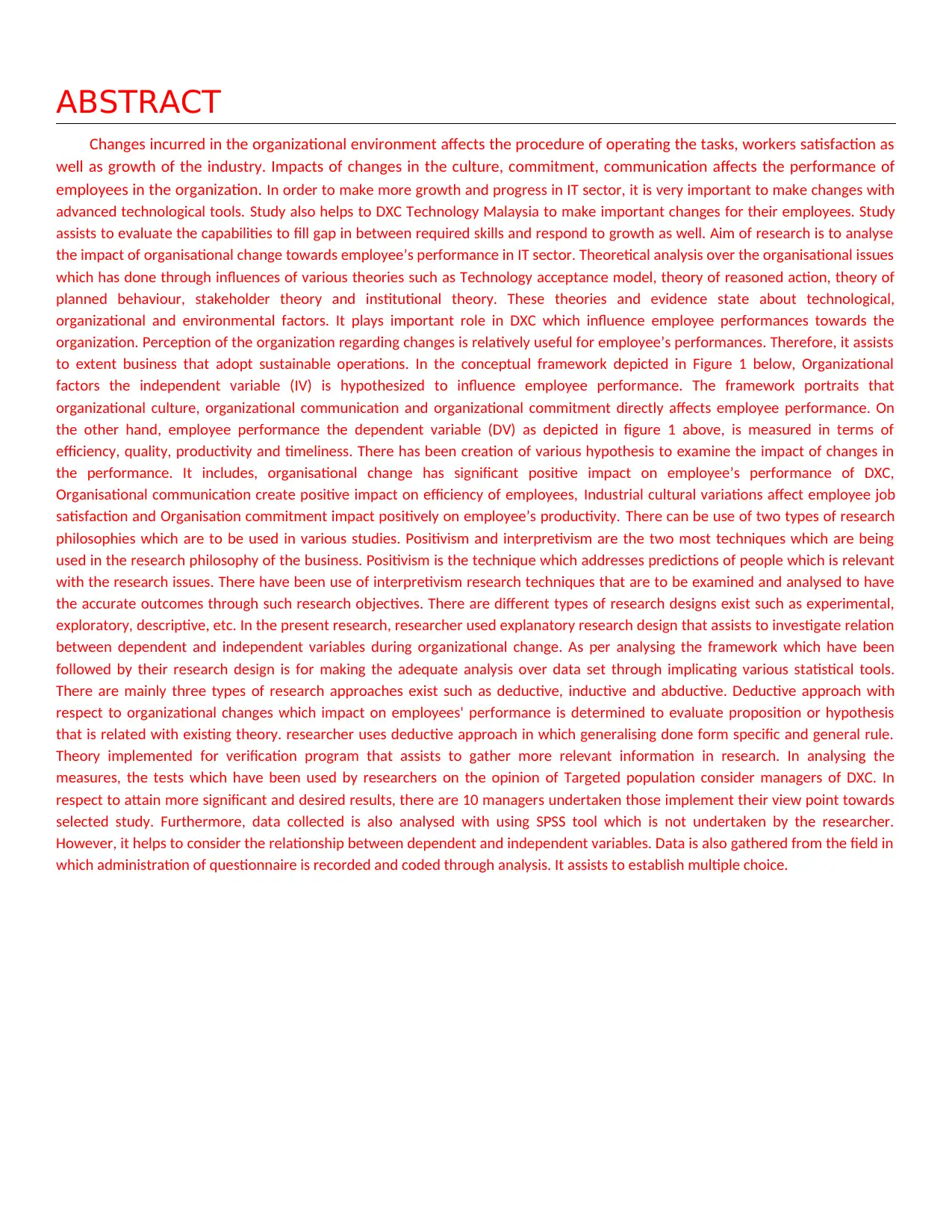
ABSTRACT
Changes incurred in the organizational environment affects the procedure of operating the tasks, workers satisfaction as
well as growth of the industry. Impacts of changes in the culture, commitment, communication affects the performance of
employees in the organization. In order to make more growth and progress in IT sector, it is very important to make changes with
advanced technological tools. Study also helps to DXC Technology Malaysia to make important changes for their employees. Study
assists to evaluate the capabilities to fill gap in between required skills and respond to growth as well. Aim of research is to analyse
the impact of organisational change towards employee’s performance in IT sector. Theoretical analysis over the organisational issues
which has done through influences of various theories such as Technology acceptance model, theory of reasoned action, theory of
planned behaviour, stakeholder theory and institutional theory. These theories and evidence state about technological,
organizational and environmental factors. It plays important role in DXC which influence employee performances towards the
organization. Perception of the organization regarding changes is relatively useful for employee’s performances. Therefore, it assists
to extent business that adopt sustainable operations. In the conceptual framework depicted in Figure 1 below, Organizational
factors the independent variable (IV) is hypothesized to influence employee performance. The framework portraits that
organizational culture, organizational communication and organizational commitment directly affects employee performance. On
the other hand, employee performance the dependent variable (DV) as depicted in figure 1 above, is measured in terms of
efficiency, quality, productivity and timeliness. There has been creation of various hypothesis to examine the impact of changes in
the performance. It includes, organisational change has significant positive impact on employee’s performance of DXC,
Organisational communication create positive impact on efficiency of employees, Industrial cultural variations affect employee job
satisfaction and Organisation commitment impact positively on employee’s productivity. There can be use of two types of research
philosophies which are to be used in various studies. Positivism and interpretivism are the two most techniques which are being
used in the research philosophy of the business. Positivism is the technique which addresses predictions of people which is relevant
with the research issues. There have been use of interpretivism research techniques that are to be examined and analysed to have
the accurate outcomes through such research objectives. There are different types of research designs exist such as experimental,
exploratory, descriptive, etc. In the present research, researcher used explanatory research design that assists to investigate relation
between dependent and independent variables during organizational change. As per analysing the framework which have been
followed by their research design is for making the adequate analysis over data set through implicating various statistical tools.
There are mainly three types of research approaches exist such as deductive, inductive and abductive. Deductive approach with
respect to organizational changes which impact on employees' performance is determined to evaluate proposition or hypothesis
that is related with existing theory. researcher uses deductive approach in which generalising done form specific and general rule.
Theory implemented for verification program that assists to gather more relevant information in research. In analysing the
measures, the tests which have been used by researchers on the opinion of Targeted population consider managers of DXC. In
respect to attain more significant and desired results, there are 10 managers undertaken those implement their view point towards
selected study. Furthermore, data collected is also analysed with using SPSS tool which is not undertaken by the researcher.
However, it helps to consider the relationship between dependent and independent variables. Data is also gathered from the field in
which administration of questionnaire is recorded and coded through analysis. It assists to establish multiple choice.
Changes incurred in the organizational environment affects the procedure of operating the tasks, workers satisfaction as
well as growth of the industry. Impacts of changes in the culture, commitment, communication affects the performance of
employees in the organization. In order to make more growth and progress in IT sector, it is very important to make changes with
advanced technological tools. Study also helps to DXC Technology Malaysia to make important changes for their employees. Study
assists to evaluate the capabilities to fill gap in between required skills and respond to growth as well. Aim of research is to analyse
the impact of organisational change towards employee’s performance in IT sector. Theoretical analysis over the organisational issues
which has done through influences of various theories such as Technology acceptance model, theory of reasoned action, theory of
planned behaviour, stakeholder theory and institutional theory. These theories and evidence state about technological,
organizational and environmental factors. It plays important role in DXC which influence employee performances towards the
organization. Perception of the organization regarding changes is relatively useful for employee’s performances. Therefore, it assists
to extent business that adopt sustainable operations. In the conceptual framework depicted in Figure 1 below, Organizational
factors the independent variable (IV) is hypothesized to influence employee performance. The framework portraits that
organizational culture, organizational communication and organizational commitment directly affects employee performance. On
the other hand, employee performance the dependent variable (DV) as depicted in figure 1 above, is measured in terms of
efficiency, quality, productivity and timeliness. There has been creation of various hypothesis to examine the impact of changes in
the performance. It includes, organisational change has significant positive impact on employee’s performance of DXC,
Organisational communication create positive impact on efficiency of employees, Industrial cultural variations affect employee job
satisfaction and Organisation commitment impact positively on employee’s productivity. There can be use of two types of research
philosophies which are to be used in various studies. Positivism and interpretivism are the two most techniques which are being
used in the research philosophy of the business. Positivism is the technique which addresses predictions of people which is relevant
with the research issues. There have been use of interpretivism research techniques that are to be examined and analysed to have
the accurate outcomes through such research objectives. There are different types of research designs exist such as experimental,
exploratory, descriptive, etc. In the present research, researcher used explanatory research design that assists to investigate relation
between dependent and independent variables during organizational change. As per analysing the framework which have been
followed by their research design is for making the adequate analysis over data set through implicating various statistical tools.
There are mainly three types of research approaches exist such as deductive, inductive and abductive. Deductive approach with
respect to organizational changes which impact on employees' performance is determined to evaluate proposition or hypothesis
that is related with existing theory. researcher uses deductive approach in which generalising done form specific and general rule.
Theory implemented for verification program that assists to gather more relevant information in research. In analysing the
measures, the tests which have been used by researchers on the opinion of Targeted population consider managers of DXC. In
respect to attain more significant and desired results, there are 10 managers undertaken those implement their view point towards
selected study. Furthermore, data collected is also analysed with using SPSS tool which is not undertaken by the researcher.
However, it helps to consider the relationship between dependent and independent variables. Data is also gathered from the field in
which administration of questionnaire is recorded and coded through analysis. It assists to establish multiple choice.
Paraphrase This Document
Need a fresh take? Get an instant paraphrase of this document with our AI Paraphraser
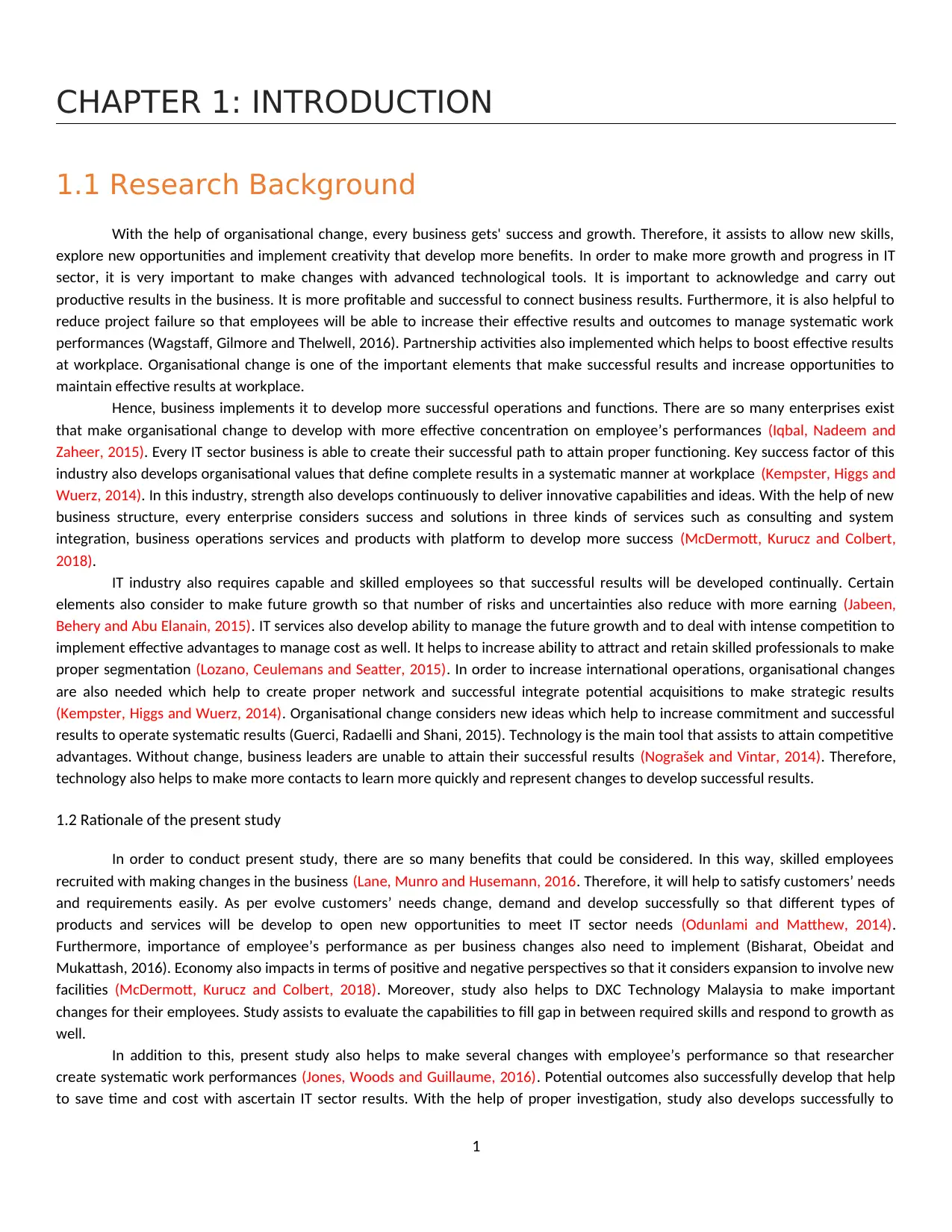
CHAPTER 1: INTRODUCTION
1.1 Research Background
With the help of organisational change, every business gets' success and growth. Therefore, it assists to allow new skills,
explore new opportunities and implement creativity that develop more benefits. In order to make more growth and progress in IT
sector, it is very important to make changes with advanced technological tools. It is important to acknowledge and carry out
productive results in the business. It is more profitable and successful to connect business results. Furthermore, it is also helpful to
reduce project failure so that employees will be able to increase their effective results and outcomes to manage systematic work
performances (Wagstaff, Gilmore and Thelwell, 2016). Partnership activities also implemented which helps to boost effective results
at workplace. Organisational change is one of the important elements that make successful results and increase opportunities to
maintain effective results at workplace.
Hence, business implements it to develop more successful operations and functions. There are so many enterprises exist
that make organisational change to develop with more effective concentration on employee’s performances (Iqbal, Nadeem and
Zaheer, 2015). Every IT sector business is able to create their successful path to attain proper functioning. Key success factor of this
industry also develops organisational values that define complete results in a systematic manner at workplace (Kempster, Higgs and
Wuerz, 2014). In this industry, strength also develops continuously to deliver innovative capabilities and ideas. With the help of new
business structure, every enterprise considers success and solutions in three kinds of services such as consulting and system
integration, business operations services and products with platform to develop more success (McDermott, Kurucz and Colbert,
2018).
IT industry also requires capable and skilled employees so that successful results will be developed continually. Certain
elements also consider to make future growth so that number of risks and uncertainties also reduce with more earning (Jabeen,
Behery and Abu Elanain, 2015). IT services also develop ability to manage the future growth and to deal with intense competition to
implement effective advantages to manage cost as well. It helps to increase ability to attract and retain skilled professionals to make
proper segmentation (Lozano, Ceulemans and Seatter, 2015). In order to increase international operations, organisational changes
are also needed which help to create proper network and successful integrate potential acquisitions to make strategic results
(Kempster, Higgs and Wuerz, 2014). Organisational change considers new ideas which help to increase commitment and successful
results to operate systematic results (Guerci, Radaelli and Shani, 2015). Technology is the main tool that assists to attain competitive
advantages. Without change, business leaders are unable to attain their successful results (Nograšek and Vintar, 2014). Therefore,
technology also helps to make more contacts to learn more quickly and represent changes to develop successful results.
1.2 Rationale of the present study
In order to conduct present study, there are so many benefits that could be considered. In this way, skilled employees
recruited with making changes in the business (Lane, Munro and Husemann, 2016. Therefore, it will help to satisfy customers’ needs
and requirements easily. As per evolve customers’ needs change, demand and develop successfully so that different types of
products and services will be develop to open new opportunities to meet IT sector needs (Odunlami and Matthew, 2014).
Furthermore, importance of employee’s performance as per business changes also need to implement (Bisharat, Obeidat and
Mukattash, 2016). Economy also impacts in terms of positive and negative perspectives so that it considers expansion to involve new
facilities (McDermott, Kurucz and Colbert, 2018). Moreover, study also helps to DXC Technology Malaysia to make important
changes for their employees. Study assists to evaluate the capabilities to fill gap in between required skills and respond to growth as
well.
In addition to this, present study also helps to make several changes with employee’s performance so that researcher
create systematic work performances (Jones, Woods and Guillaume, 2016). Potential outcomes also successfully develop that help
to save time and cost with ascertain IT sector results. With the help of proper investigation, study also develops successfully to
1
1.1 Research Background
With the help of organisational change, every business gets' success and growth. Therefore, it assists to allow new skills,
explore new opportunities and implement creativity that develop more benefits. In order to make more growth and progress in IT
sector, it is very important to make changes with advanced technological tools. It is important to acknowledge and carry out
productive results in the business. It is more profitable and successful to connect business results. Furthermore, it is also helpful to
reduce project failure so that employees will be able to increase their effective results and outcomes to manage systematic work
performances (Wagstaff, Gilmore and Thelwell, 2016). Partnership activities also implemented which helps to boost effective results
at workplace. Organisational change is one of the important elements that make successful results and increase opportunities to
maintain effective results at workplace.
Hence, business implements it to develop more successful operations and functions. There are so many enterprises exist
that make organisational change to develop with more effective concentration on employee’s performances (Iqbal, Nadeem and
Zaheer, 2015). Every IT sector business is able to create their successful path to attain proper functioning. Key success factor of this
industry also develops organisational values that define complete results in a systematic manner at workplace (Kempster, Higgs and
Wuerz, 2014). In this industry, strength also develops continuously to deliver innovative capabilities and ideas. With the help of new
business structure, every enterprise considers success and solutions in three kinds of services such as consulting and system
integration, business operations services and products with platform to develop more success (McDermott, Kurucz and Colbert,
2018).
IT industry also requires capable and skilled employees so that successful results will be developed continually. Certain
elements also consider to make future growth so that number of risks and uncertainties also reduce with more earning (Jabeen,
Behery and Abu Elanain, 2015). IT services also develop ability to manage the future growth and to deal with intense competition to
implement effective advantages to manage cost as well. It helps to increase ability to attract and retain skilled professionals to make
proper segmentation (Lozano, Ceulemans and Seatter, 2015). In order to increase international operations, organisational changes
are also needed which help to create proper network and successful integrate potential acquisitions to make strategic results
(Kempster, Higgs and Wuerz, 2014). Organisational change considers new ideas which help to increase commitment and successful
results to operate systematic results (Guerci, Radaelli and Shani, 2015). Technology is the main tool that assists to attain competitive
advantages. Without change, business leaders are unable to attain their successful results (Nograšek and Vintar, 2014). Therefore,
technology also helps to make more contacts to learn more quickly and represent changes to develop successful results.
1.2 Rationale of the present study
In order to conduct present study, there are so many benefits that could be considered. In this way, skilled employees
recruited with making changes in the business (Lane, Munro and Husemann, 2016. Therefore, it will help to satisfy customers’ needs
and requirements easily. As per evolve customers’ needs change, demand and develop successfully so that different types of
products and services will be develop to open new opportunities to meet IT sector needs (Odunlami and Matthew, 2014).
Furthermore, importance of employee’s performance as per business changes also need to implement (Bisharat, Obeidat and
Mukattash, 2016). Economy also impacts in terms of positive and negative perspectives so that it considers expansion to involve new
facilities (McDermott, Kurucz and Colbert, 2018). Moreover, study also helps to DXC Technology Malaysia to make important
changes for their employees. Study assists to evaluate the capabilities to fill gap in between required skills and respond to growth as
well.
In addition to this, present study also helps to make several changes with employee’s performance so that researcher
create systematic work performances (Jones, Woods and Guillaume, 2016). Potential outcomes also successfully develop that help
to save time and cost with ascertain IT sector results. With the help of proper investigation, study also develops successfully to
1
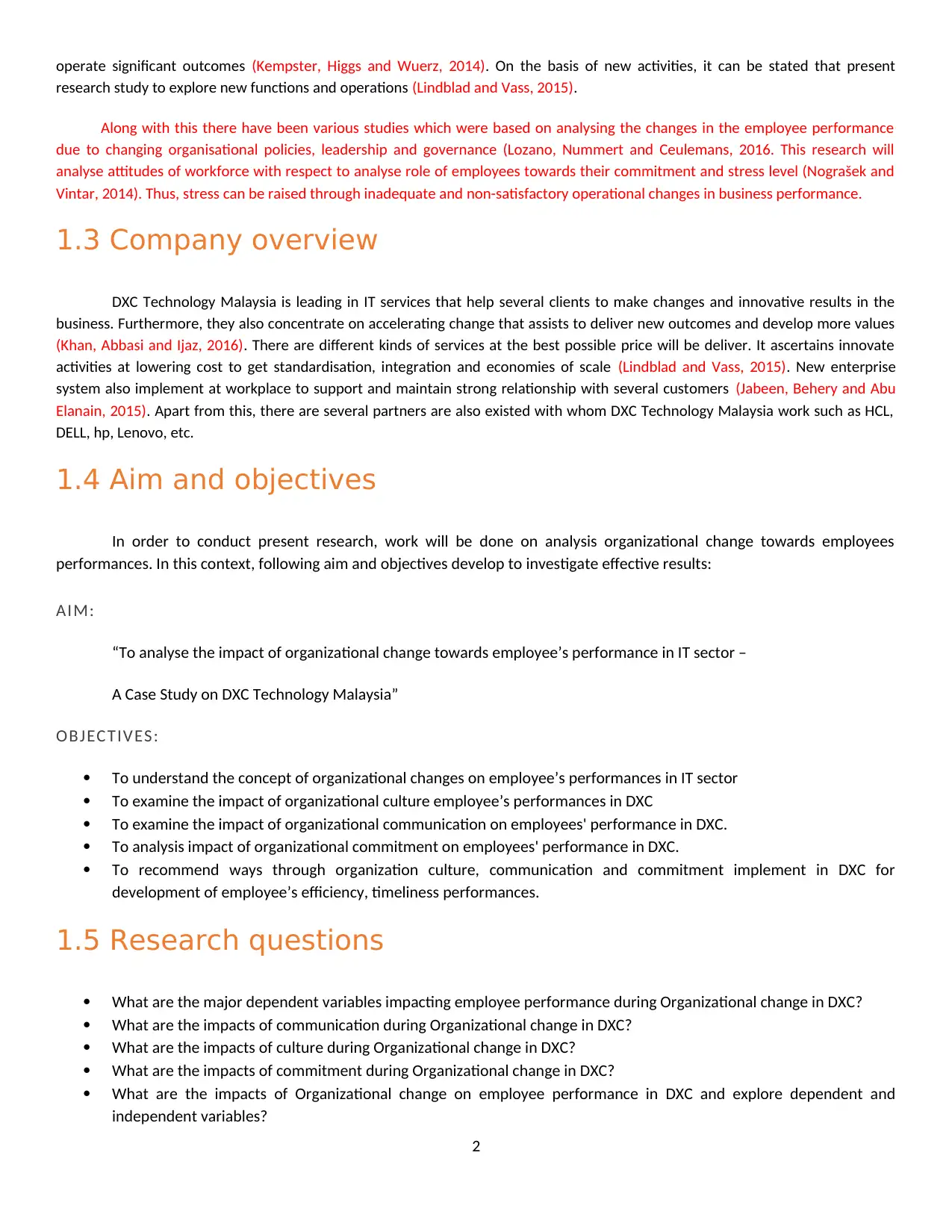
operate significant outcomes (Kempster, Higgs and Wuerz, 2014). On the basis of new activities, it can be stated that present
research study to explore new functions and operations (Lindblad and Vass, 2015).
Along with this there have been various studies which were based on analysing the changes in the employee performance
due to changing organisational policies, leadership and governance (Lozano, Nummert and Ceulemans, 2016. This research will
analyse attitudes of workforce with respect to analyse role of employees towards their commitment and stress level (Nograšek and
Vintar, 2014). Thus, stress can be raised through inadequate and non-satisfactory operational changes in business performance.
1.3 Company overview
DXC Technology Malaysia is leading in IT services that help several clients to make changes and innovative results in the
business. Furthermore, they also concentrate on accelerating change that assists to deliver new outcomes and develop more values
(Khan, Abbasi and Ijaz, 2016). There are different kinds of services at the best possible price will be deliver. It ascertains innovate
activities at lowering cost to get standardisation, integration and economies of scale (Lindblad and Vass, 2015). New enterprise
system also implement at workplace to support and maintain strong relationship with several customers (Jabeen, Behery and Abu
Elanain, 2015). Apart from this, there are several partners are also existed with whom DXC Technology Malaysia work such as HCL,
DELL, hp, Lenovo, etc.
1.4 Aim and objectives
In order to conduct present research, work will be done on analysis organizational change towards employees
performances. In this context, following aim and objectives develop to investigate effective results:
AIM:
“To analyse the impact of organizational change towards employee’s performance in IT sector –
A Case Study on DXC Technology Malaysia”
OBJECTIVES:
To understand the concept of organizational changes on employee’s performances in IT sector
To examine the impact of organizational culture employee’s performances in DXC
To examine the impact of organizational communication on employees' performance in DXC.
To analysis impact of organizational commitment on employees' performance in DXC.
To recommend ways through organization culture, communication and commitment implement in DXC for
development of employee’s efficiency, timeliness performances.
1.5 Research questions
What are the major dependent variables impacting employee performance during Organizational change in DXC?
What are the impacts of communication during Organizational change in DXC?
What are the impacts of culture during Organizational change in DXC?
What are the impacts of commitment during Organizational change in DXC?
What are the impacts of Organizational change on employee performance in DXC and explore dependent and
independent variables?
2
research study to explore new functions and operations (Lindblad and Vass, 2015).
Along with this there have been various studies which were based on analysing the changes in the employee performance
due to changing organisational policies, leadership and governance (Lozano, Nummert and Ceulemans, 2016. This research will
analyse attitudes of workforce with respect to analyse role of employees towards their commitment and stress level (Nograšek and
Vintar, 2014). Thus, stress can be raised through inadequate and non-satisfactory operational changes in business performance.
1.3 Company overview
DXC Technology Malaysia is leading in IT services that help several clients to make changes and innovative results in the
business. Furthermore, they also concentrate on accelerating change that assists to deliver new outcomes and develop more values
(Khan, Abbasi and Ijaz, 2016). There are different kinds of services at the best possible price will be deliver. It ascertains innovate
activities at lowering cost to get standardisation, integration and economies of scale (Lindblad and Vass, 2015). New enterprise
system also implement at workplace to support and maintain strong relationship with several customers (Jabeen, Behery and Abu
Elanain, 2015). Apart from this, there are several partners are also existed with whom DXC Technology Malaysia work such as HCL,
DELL, hp, Lenovo, etc.
1.4 Aim and objectives
In order to conduct present research, work will be done on analysis organizational change towards employees
performances. In this context, following aim and objectives develop to investigate effective results:
AIM:
“To analyse the impact of organizational change towards employee’s performance in IT sector –
A Case Study on DXC Technology Malaysia”
OBJECTIVES:
To understand the concept of organizational changes on employee’s performances in IT sector
To examine the impact of organizational culture employee’s performances in DXC
To examine the impact of organizational communication on employees' performance in DXC.
To analysis impact of organizational commitment on employees' performance in DXC.
To recommend ways through organization culture, communication and commitment implement in DXC for
development of employee’s efficiency, timeliness performances.
1.5 Research questions
What are the major dependent variables impacting employee performance during Organizational change in DXC?
What are the impacts of communication during Organizational change in DXC?
What are the impacts of culture during Organizational change in DXC?
What are the impacts of commitment during Organizational change in DXC?
What are the impacts of Organizational change on employee performance in DXC and explore dependent and
independent variables?
2
⊘ This is a preview!⊘
Do you want full access?
Subscribe today to unlock all pages.

Trusted by 1+ million students worldwide
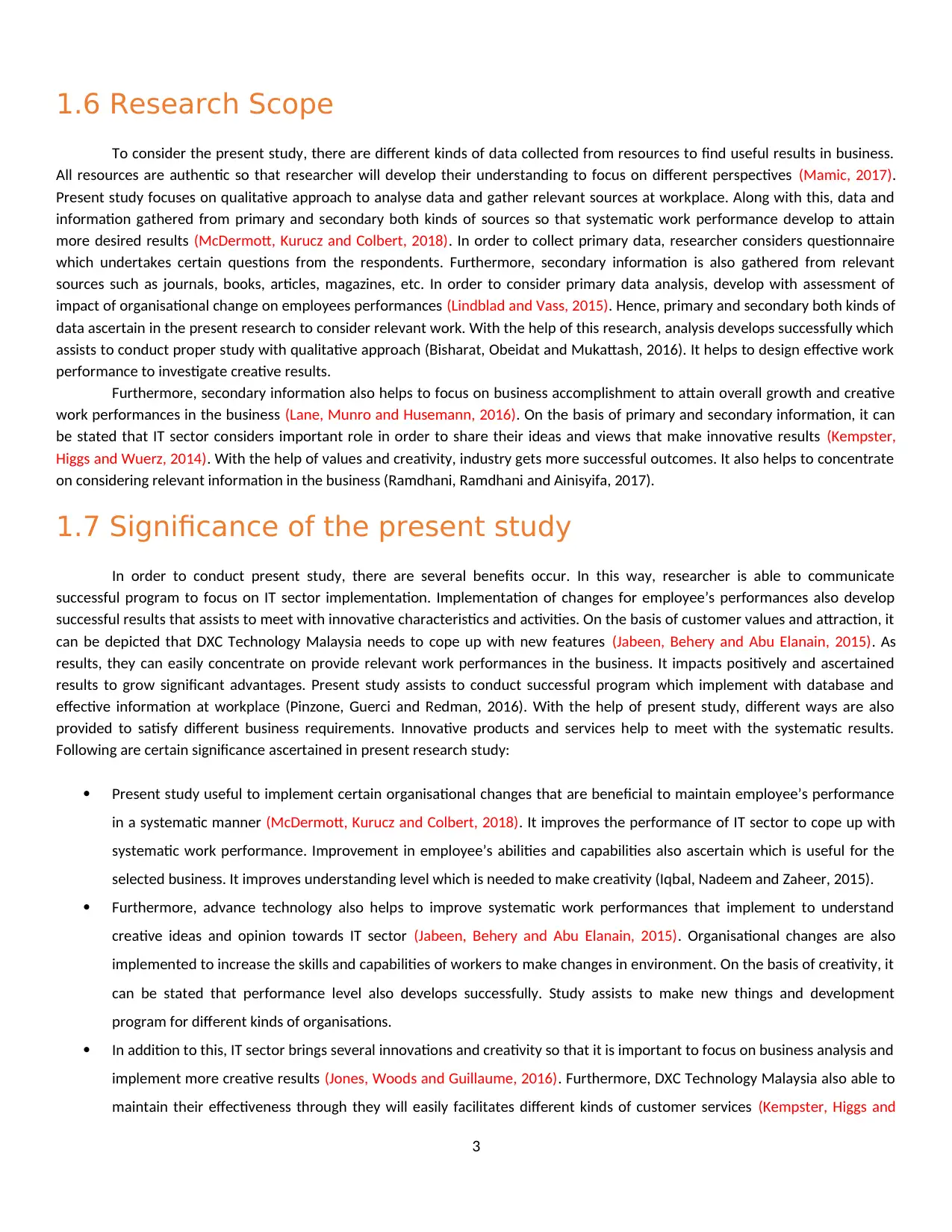
1.6 Research Scope
To consider the present study, there are different kinds of data collected from resources to find useful results in business.
All resources are authentic so that researcher will develop their understanding to focus on different perspectives (Mamic, 2017).
Present study focuses on qualitative approach to analyse data and gather relevant sources at workplace. Along with this, data and
information gathered from primary and secondary both kinds of sources so that systematic work performance develop to attain
more desired results (McDermott, Kurucz and Colbert, 2018). In order to collect primary data, researcher considers questionnaire
which undertakes certain questions from the respondents. Furthermore, secondary information is also gathered from relevant
sources such as journals, books, articles, magazines, etc. In order to consider primary data analysis, develop with assessment of
impact of organisational change on employees performances (Lindblad and Vass, 2015). Hence, primary and secondary both kinds of
data ascertain in the present research to consider relevant work. With the help of this research, analysis develops successfully which
assists to conduct proper study with qualitative approach (Bisharat, Obeidat and Mukattash, 2016). It helps to design effective work
performance to investigate creative results.
Furthermore, secondary information also helps to focus on business accomplishment to attain overall growth and creative
work performances in the business (Lane, Munro and Husemann, 2016). On the basis of primary and secondary information, it can
be stated that IT sector considers important role in order to share their ideas and views that make innovative results (Kempster,
Higgs and Wuerz, 2014). With the help of values and creativity, industry gets more successful outcomes. It also helps to concentrate
on considering relevant information in the business (Ramdhani, Ramdhani and Ainisyifa, 2017).
1.7 Significance of the present study
In order to conduct present study, there are several benefits occur. In this way, researcher is able to communicate
successful program to focus on IT sector implementation. Implementation of changes for employee’s performances also develop
successful results that assists to meet with innovative characteristics and activities. On the basis of customer values and attraction, it
can be depicted that DXC Technology Malaysia needs to cope up with new features (Jabeen, Behery and Abu Elanain, 2015). As
results, they can easily concentrate on provide relevant work performances in the business. It impacts positively and ascertained
results to grow significant advantages. Present study assists to conduct successful program which implement with database and
effective information at workplace (Pinzone, Guerci and Redman, 2016). With the help of present study, different ways are also
provided to satisfy different business requirements. Innovative products and services help to meet with the systematic results.
Following are certain significance ascertained in present research study:
Present study useful to implement certain organisational changes that are beneficial to maintain employee’s performance
in a systematic manner (McDermott, Kurucz and Colbert, 2018). It improves the performance of IT sector to cope up with
systematic work performance. Improvement in employee’s abilities and capabilities also ascertain which is useful for the
selected business. It improves understanding level which is needed to make creativity (Iqbal, Nadeem and Zaheer, 2015).
Furthermore, advance technology also helps to improve systematic work performances that implement to understand
creative ideas and opinion towards IT sector (Jabeen, Behery and Abu Elanain, 2015). Organisational changes are also
implemented to increase the skills and capabilities of workers to make changes in environment. On the basis of creativity, it
can be stated that performance level also develops successfully. Study assists to make new things and development
program for different kinds of organisations.
In addition to this, IT sector brings several innovations and creativity so that it is important to focus on business analysis and
implement more creative results (Jones, Woods and Guillaume, 2016). Furthermore, DXC Technology Malaysia also able to
maintain their effectiveness through they will easily facilitates different kinds of customer services (Kempster, Higgs and
3
To consider the present study, there are different kinds of data collected from resources to find useful results in business.
All resources are authentic so that researcher will develop their understanding to focus on different perspectives (Mamic, 2017).
Present study focuses on qualitative approach to analyse data and gather relevant sources at workplace. Along with this, data and
information gathered from primary and secondary both kinds of sources so that systematic work performance develop to attain
more desired results (McDermott, Kurucz and Colbert, 2018). In order to collect primary data, researcher considers questionnaire
which undertakes certain questions from the respondents. Furthermore, secondary information is also gathered from relevant
sources such as journals, books, articles, magazines, etc. In order to consider primary data analysis, develop with assessment of
impact of organisational change on employees performances (Lindblad and Vass, 2015). Hence, primary and secondary both kinds of
data ascertain in the present research to consider relevant work. With the help of this research, analysis develops successfully which
assists to conduct proper study with qualitative approach (Bisharat, Obeidat and Mukattash, 2016). It helps to design effective work
performance to investigate creative results.
Furthermore, secondary information also helps to focus on business accomplishment to attain overall growth and creative
work performances in the business (Lane, Munro and Husemann, 2016). On the basis of primary and secondary information, it can
be stated that IT sector considers important role in order to share their ideas and views that make innovative results (Kempster,
Higgs and Wuerz, 2014). With the help of values and creativity, industry gets more successful outcomes. It also helps to concentrate
on considering relevant information in the business (Ramdhani, Ramdhani and Ainisyifa, 2017).
1.7 Significance of the present study
In order to conduct present study, there are several benefits occur. In this way, researcher is able to communicate
successful program to focus on IT sector implementation. Implementation of changes for employee’s performances also develop
successful results that assists to meet with innovative characteristics and activities. On the basis of customer values and attraction, it
can be depicted that DXC Technology Malaysia needs to cope up with new features (Jabeen, Behery and Abu Elanain, 2015). As
results, they can easily concentrate on provide relevant work performances in the business. It impacts positively and ascertained
results to grow significant advantages. Present study assists to conduct successful program which implement with database and
effective information at workplace (Pinzone, Guerci and Redman, 2016). With the help of present study, different ways are also
provided to satisfy different business requirements. Innovative products and services help to meet with the systematic results.
Following are certain significance ascertained in present research study:
Present study useful to implement certain organisational changes that are beneficial to maintain employee’s performance
in a systematic manner (McDermott, Kurucz and Colbert, 2018). It improves the performance of IT sector to cope up with
systematic work performance. Improvement in employee’s abilities and capabilities also ascertain which is useful for the
selected business. It improves understanding level which is needed to make creativity (Iqbal, Nadeem and Zaheer, 2015).
Furthermore, advance technology also helps to improve systematic work performances that implement to understand
creative ideas and opinion towards IT sector (Jabeen, Behery and Abu Elanain, 2015). Organisational changes are also
implemented to increase the skills and capabilities of workers to make changes in environment. On the basis of creativity, it
can be stated that performance level also develops successfully. Study assists to make new things and development
program for different kinds of organisations.
In addition to this, IT sector brings several innovations and creativity so that it is important to focus on business analysis and
implement more creative results (Jones, Woods and Guillaume, 2016). Furthermore, DXC Technology Malaysia also able to
maintain their effectiveness through they will easily facilitates different kinds of customer services (Kempster, Higgs and
3
Paraphrase This Document
Need a fresh take? Get an instant paraphrase of this document with our AI Paraphraser
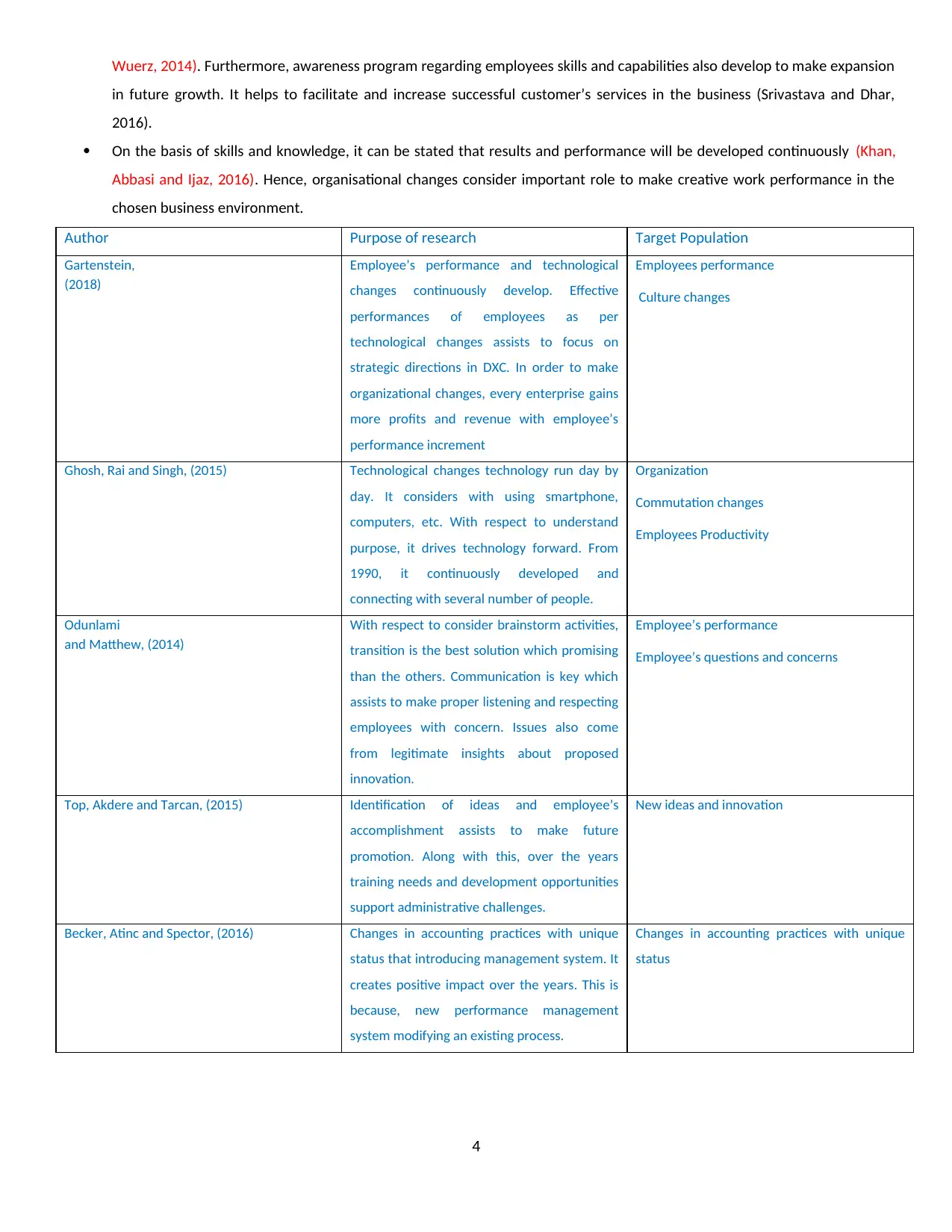
Wuerz, 2014). Furthermore, awareness program regarding employees skills and capabilities also develop to make expansion
in future growth. It helps to facilitate and increase successful customer’s services in the business (Srivastava and Dhar,
2016).
On the basis of skills and knowledge, it can be stated that results and performance will be developed continuously (Khan,
Abbasi and Ijaz, 2016). Hence, organisational changes consider important role to make creative work performance in the
chosen business environment.
Author Purpose of research Target Population
Gartenstein,
(2018)
Employee’s performance and technological
changes continuously develop. Effective
performances of employees as per
technological changes assists to focus on
strategic directions in DXC. In order to make
organizational changes, every enterprise gains
more profits and revenue with employee’s
performance increment
Employees performance
Culture changes
Ghosh, Rai and Singh, (2015) Technological changes technology run day by
day. It considers with using smartphone,
computers, etc. With respect to understand
purpose, it drives technology forward. From
1990, it continuously developed and
connecting with several number of people.
Organization
Commutation changes
Employees Productivity
Odunlami
and Matthew, (2014)
With respect to consider brainstorm activities,
transition is the best solution which promising
than the others. Communication is key which
assists to make proper listening and respecting
employees with concern. Issues also come
from legitimate insights about proposed
innovation.
Employee’s performance
Employee’s questions and concerns
Top, Akdere and Tarcan, (2015) Identification of ideas and employee’s
accomplishment assists to make future
promotion. Along with this, over the years
training needs and development opportunities
support administrative challenges.
New ideas and innovation
Becker, Atinc and Spector, (2016) Changes in accounting practices with unique
status that introducing management system. It
creates positive impact over the years. This is
because, new performance management
system modifying an existing process.
Changes in accounting practices with unique
status
4
in future growth. It helps to facilitate and increase successful customer’s services in the business (Srivastava and Dhar,
2016).
On the basis of skills and knowledge, it can be stated that results and performance will be developed continuously (Khan,
Abbasi and Ijaz, 2016). Hence, organisational changes consider important role to make creative work performance in the
chosen business environment.
Author Purpose of research Target Population
Gartenstein,
(2018)
Employee’s performance and technological
changes continuously develop. Effective
performances of employees as per
technological changes assists to focus on
strategic directions in DXC. In order to make
organizational changes, every enterprise gains
more profits and revenue with employee’s
performance increment
Employees performance
Culture changes
Ghosh, Rai and Singh, (2015) Technological changes technology run day by
day. It considers with using smartphone,
computers, etc. With respect to understand
purpose, it drives technology forward. From
1990, it continuously developed and
connecting with several number of people.
Organization
Commutation changes
Employees Productivity
Odunlami
and Matthew, (2014)
With respect to consider brainstorm activities,
transition is the best solution which promising
than the others. Communication is key which
assists to make proper listening and respecting
employees with concern. Issues also come
from legitimate insights about proposed
innovation.
Employee’s performance
Employee’s questions and concerns
Top, Akdere and Tarcan, (2015) Identification of ideas and employee’s
accomplishment assists to make future
promotion. Along with this, over the years
training needs and development opportunities
support administrative challenges.
New ideas and innovation
Becker, Atinc and Spector, (2016) Changes in accounting practices with unique
status that introducing management system. It
creates positive impact over the years. This is
because, new performance management
system modifying an existing process.
Changes in accounting practices with unique
status
4
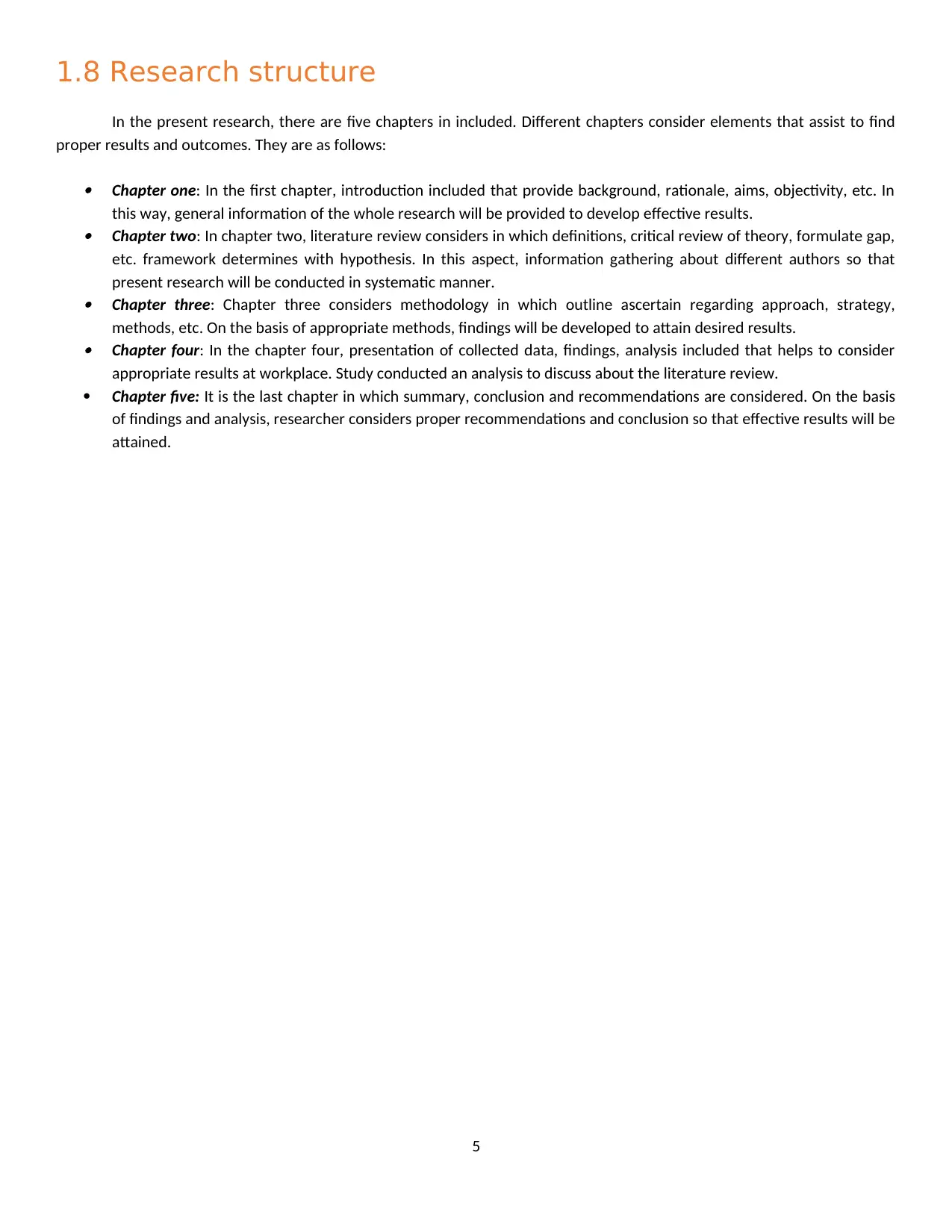
1.8 Research structure
In the present research, there are five chapters in included. Different chapters consider elements that assist to find
proper results and outcomes. They are as follows:
Chapter one: In the first chapter, introduction included that provide background, rationale, aims, objectivity, etc. In
this way, general information of the whole research will be provided to develop effective results. Chapter two: In chapter two, literature review considers in which definitions, critical review of theory, formulate gap,
etc. framework determines with hypothesis. In this aspect, information gathering about different authors so that
present research will be conducted in systematic manner. Chapter three: Chapter three considers methodology in which outline ascertain regarding approach, strategy,
methods, etc. On the basis of appropriate methods, findings will be developed to attain desired results. Chapter four: In the chapter four, presentation of collected data, findings, analysis included that helps to consider
appropriate results at workplace. Study conducted an analysis to discuss about the literature review.
Chapter five: It is the last chapter in which summary, conclusion and recommendations are considered. On the basis
of findings and analysis, researcher considers proper recommendations and conclusion so that effective results will be
attained.
5
In the present research, there are five chapters in included. Different chapters consider elements that assist to find
proper results and outcomes. They are as follows:
Chapter one: In the first chapter, introduction included that provide background, rationale, aims, objectivity, etc. In
this way, general information of the whole research will be provided to develop effective results. Chapter two: In chapter two, literature review considers in which definitions, critical review of theory, formulate gap,
etc. framework determines with hypothesis. In this aspect, information gathering about different authors so that
present research will be conducted in systematic manner. Chapter three: Chapter three considers methodology in which outline ascertain regarding approach, strategy,
methods, etc. On the basis of appropriate methods, findings will be developed to attain desired results. Chapter four: In the chapter four, presentation of collected data, findings, analysis included that helps to consider
appropriate results at workplace. Study conducted an analysis to discuss about the literature review.
Chapter five: It is the last chapter in which summary, conclusion and recommendations are considered. On the basis
of findings and analysis, researcher considers proper recommendations and conclusion so that effective results will be
attained.
5
⊘ This is a preview!⊘
Do you want full access?
Subscribe today to unlock all pages.

Trusted by 1+ million students worldwide
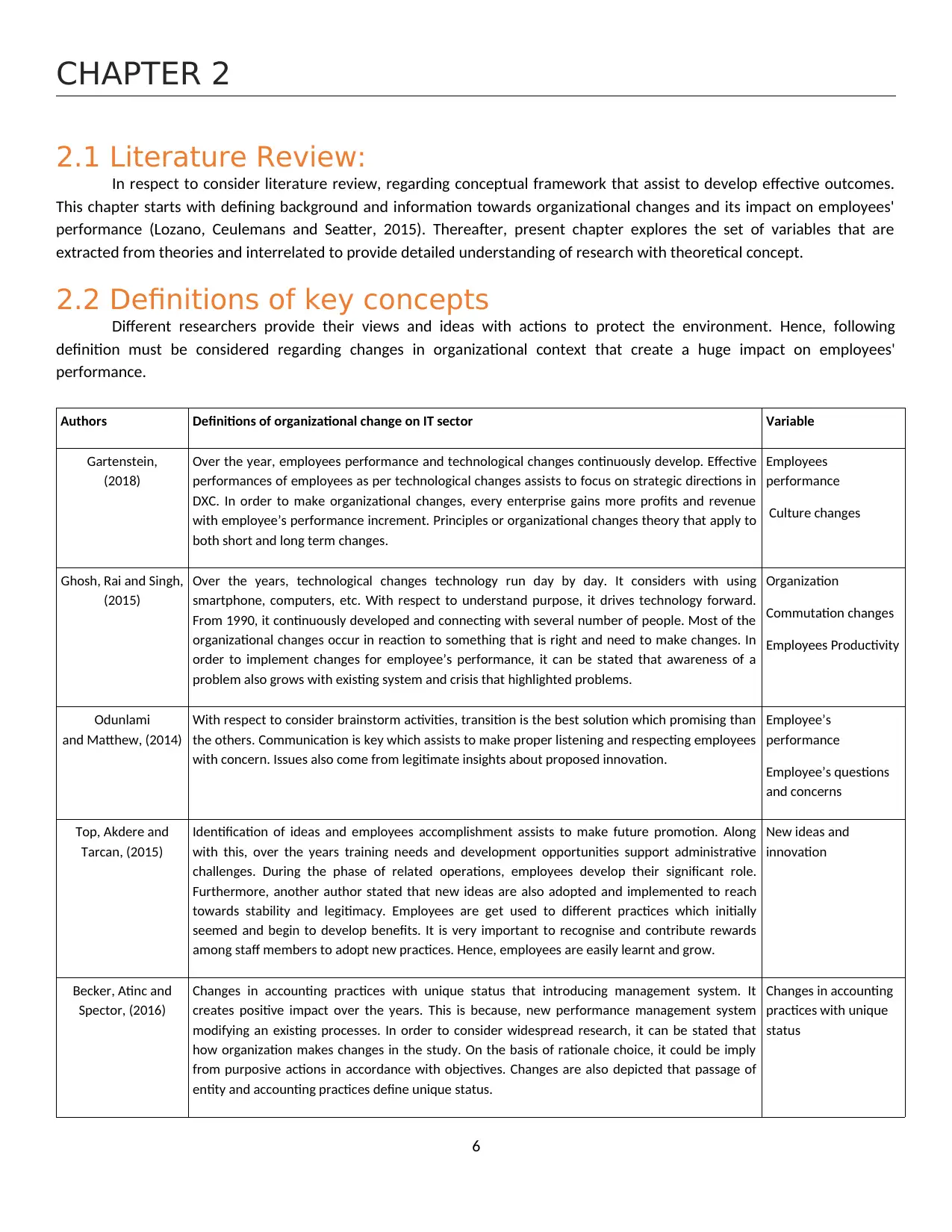
CHAPTER 2
2.1 Literature Review:
In respect to consider literature review, regarding conceptual framework that assist to develop effective outcomes.
This chapter starts with defining background and information towards organizational changes and its impact on employees'
performance (Lozano, Ceulemans and Seatter, 2015). Thereafter, present chapter explores the set of variables that are
extracted from theories and interrelated to provide detailed understanding of research with theoretical concept.
2.2 Definitions of key concepts
Different researchers provide their views and ideas with actions to protect the environment. Hence, following
definition must be considered regarding changes in organizational context that create a huge impact on employees'
performance.
Authors Definitions of organizational change on IT sector Variable
Gartenstein,
(2018)
Over the year, employees performance and technological changes continuously develop. Effective
performances of employees as per technological changes assists to focus on strategic directions in
DXC. In order to make organizational changes, every enterprise gains more profits and revenue
with employee’s performance increment. Principles or organizational changes theory that apply to
both short and long term changes.
Employees
performance
Culture changes
Ghosh, Rai and Singh,
(2015)
Over the years, technological changes technology run day by day. It considers with using
smartphone, computers, etc. With respect to understand purpose, it drives technology forward.
From 1990, it continuously developed and connecting with several number of people. Most of the
organizational changes occur in reaction to something that is right and need to make changes. In
order to implement changes for employee’s performance, it can be stated that awareness of a
problem also grows with existing system and crisis that highlighted problems.
Organization
Commutation changes
Employees Productivity
Odunlami
and Matthew, (2014)
With respect to consider brainstorm activities, transition is the best solution which promising than
the others. Communication is key which assists to make proper listening and respecting employees
with concern. Issues also come from legitimate insights about proposed innovation.
Employee’s
performance
Employee’s questions
and concerns
Top, Akdere and
Tarcan, (2015)
Identification of ideas and employees accomplishment assists to make future promotion. Along
with this, over the years training needs and development opportunities support administrative
challenges. During the phase of related operations, employees develop their significant role.
Furthermore, another author stated that new ideas are also adopted and implemented to reach
towards stability and legitimacy. Employees are get used to different practices which initially
seemed and begin to develop benefits. It is very important to recognise and contribute rewards
among staff members to adopt new practices. Hence, employees are easily learnt and grow.
New ideas and
innovation
Becker, Atinc and
Spector, (2016)
Changes in accounting practices with unique status that introducing management system. It
creates positive impact over the years. This is because, new performance management system
modifying an existing processes. In order to consider widespread research, it can be stated that
how organization makes changes in the study. On the basis of rationale choice, it could be imply
from purposive actions in accordance with objectives. Changes are also depicted that passage of
entity and accounting practices define unique status.
Changes in accounting
practices with unique
status
6
2.1 Literature Review:
In respect to consider literature review, regarding conceptual framework that assist to develop effective outcomes.
This chapter starts with defining background and information towards organizational changes and its impact on employees'
performance (Lozano, Ceulemans and Seatter, 2015). Thereafter, present chapter explores the set of variables that are
extracted from theories and interrelated to provide detailed understanding of research with theoretical concept.
2.2 Definitions of key concepts
Different researchers provide their views and ideas with actions to protect the environment. Hence, following
definition must be considered regarding changes in organizational context that create a huge impact on employees'
performance.
Authors Definitions of organizational change on IT sector Variable
Gartenstein,
(2018)
Over the year, employees performance and technological changes continuously develop. Effective
performances of employees as per technological changes assists to focus on strategic directions in
DXC. In order to make organizational changes, every enterprise gains more profits and revenue
with employee’s performance increment. Principles or organizational changes theory that apply to
both short and long term changes.
Employees
performance
Culture changes
Ghosh, Rai and Singh,
(2015)
Over the years, technological changes technology run day by day. It considers with using
smartphone, computers, etc. With respect to understand purpose, it drives technology forward.
From 1990, it continuously developed and connecting with several number of people. Most of the
organizational changes occur in reaction to something that is right and need to make changes. In
order to implement changes for employee’s performance, it can be stated that awareness of a
problem also grows with existing system and crisis that highlighted problems.
Organization
Commutation changes
Employees Productivity
Odunlami
and Matthew, (2014)
With respect to consider brainstorm activities, transition is the best solution which promising than
the others. Communication is key which assists to make proper listening and respecting employees
with concern. Issues also come from legitimate insights about proposed innovation.
Employee’s
performance
Employee’s questions
and concerns
Top, Akdere and
Tarcan, (2015)
Identification of ideas and employees accomplishment assists to make future promotion. Along
with this, over the years training needs and development opportunities support administrative
challenges. During the phase of related operations, employees develop their significant role.
Furthermore, another author stated that new ideas are also adopted and implemented to reach
towards stability and legitimacy. Employees are get used to different practices which initially
seemed and begin to develop benefits. It is very important to recognise and contribute rewards
among staff members to adopt new practices. Hence, employees are easily learnt and grow.
New ideas and
innovation
Becker, Atinc and
Spector, (2016)
Changes in accounting practices with unique status that introducing management system. It
creates positive impact over the years. This is because, new performance management system
modifying an existing processes. In order to consider widespread research, it can be stated that
how organization makes changes in the study. On the basis of rationale choice, it could be imply
from purposive actions in accordance with objectives. Changes are also depicted that passage of
entity and accounting practices define unique status.
Changes in accounting
practices with unique
status
6
Paraphrase This Document
Need a fresh take? Get an instant paraphrase of this document with our AI Paraphraser
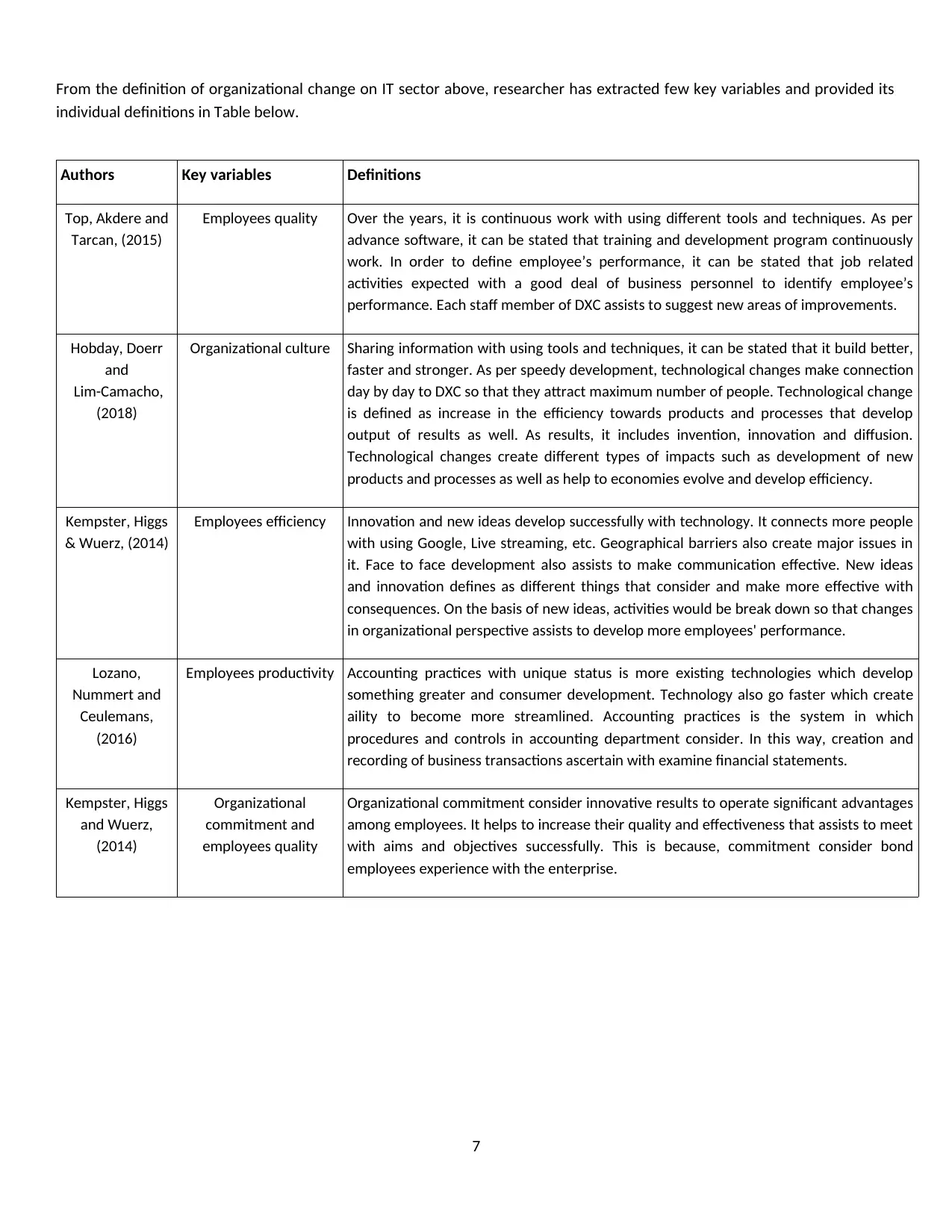
From the definition of organizational change on IT sector above, researcher has extracted few key variables and provided its
individual definitions in Table below.
Authors Key variables Definitions
Top, Akdere and
Tarcan, (2015)
Employees quality Over the years, it is continuous work with using different tools and techniques. As per
advance software, it can be stated that training and development program continuously
work. In order to define employee’s performance, it can be stated that job related
activities expected with a good deal of business personnel to identify employee’s
performance. Each staff member of DXC assists to suggest new areas of improvements.
Hobday, Doerr
and
Lim-Camacho,
(2018)
Organizational culture Sharing information with using tools and techniques, it can be stated that it build better,
faster and stronger. As per speedy development, technological changes make connection
day by day to DXC so that they attract maximum number of people. Technological change
is defined as increase in the efficiency towards products and processes that develop
output of results as well. As results, it includes invention, innovation and diffusion.
Technological changes create different types of impacts such as development of new
products and processes as well as help to economies evolve and develop efficiency.
Kempster, Higgs
& Wuerz, (2014)
Employees efficiency Innovation and new ideas develop successfully with technology. It connects more people
with using Google, Live streaming, etc. Geographical barriers also create major issues in
it. Face to face development also assists to make communication effective. New ideas
and innovation defines as different things that consider and make more effective with
consequences. On the basis of new ideas, activities would be break down so that changes
in organizational perspective assists to develop more employees' performance.
Lozano,
Nummert and
Ceulemans,
(2016)
Employees productivity Accounting practices with unique status is more existing technologies which develop
something greater and consumer development. Technology also go faster which create
aility to become more streamlined. Accounting practices is the system in which
procedures and controls in accounting department consider. In this way, creation and
recording of business transactions ascertain with examine financial statements.
Kempster, Higgs
and Wuerz,
(2014)
Organizational
commitment and
employees quality
Organizational commitment consider innovative results to operate significant advantages
among employees. It helps to increase their quality and effectiveness that assists to meet
with aims and objectives successfully. This is because, commitment consider bond
employees experience with the enterprise.
7
individual definitions in Table below.
Authors Key variables Definitions
Top, Akdere and
Tarcan, (2015)
Employees quality Over the years, it is continuous work with using different tools and techniques. As per
advance software, it can be stated that training and development program continuously
work. In order to define employee’s performance, it can be stated that job related
activities expected with a good deal of business personnel to identify employee’s
performance. Each staff member of DXC assists to suggest new areas of improvements.
Hobday, Doerr
and
Lim-Camacho,
(2018)
Organizational culture Sharing information with using tools and techniques, it can be stated that it build better,
faster and stronger. As per speedy development, technological changes make connection
day by day to DXC so that they attract maximum number of people. Technological change
is defined as increase in the efficiency towards products and processes that develop
output of results as well. As results, it includes invention, innovation and diffusion.
Technological changes create different types of impacts such as development of new
products and processes as well as help to economies evolve and develop efficiency.
Kempster, Higgs
& Wuerz, (2014)
Employees efficiency Innovation and new ideas develop successfully with technology. It connects more people
with using Google, Live streaming, etc. Geographical barriers also create major issues in
it. Face to face development also assists to make communication effective. New ideas
and innovation defines as different things that consider and make more effective with
consequences. On the basis of new ideas, activities would be break down so that changes
in organizational perspective assists to develop more employees' performance.
Lozano,
Nummert and
Ceulemans,
(2016)
Employees productivity Accounting practices with unique status is more existing technologies which develop
something greater and consumer development. Technology also go faster which create
aility to become more streamlined. Accounting practices is the system in which
procedures and controls in accounting department consider. In this way, creation and
recording of business transactions ascertain with examine financial statements.
Kempster, Higgs
and Wuerz,
(2014)
Organizational
commitment and
employees quality
Organizational commitment consider innovative results to operate significant advantages
among employees. It helps to increase their quality and effectiveness that assists to meet
with aims and objectives successfully. This is because, commitment consider bond
employees experience with the enterprise.
7
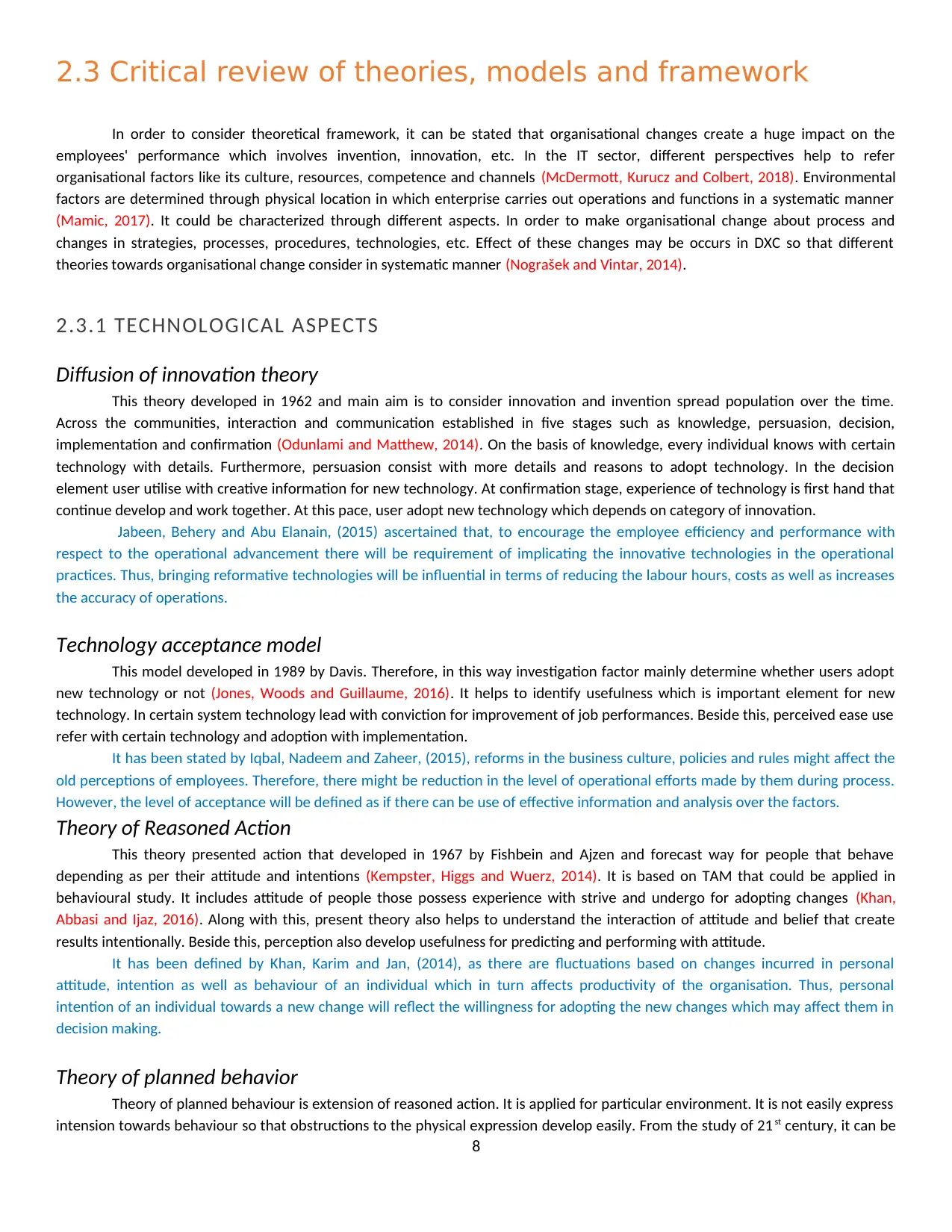
2.3 Critical review of theories, models and framework
In order to consider theoretical framework, it can be stated that organisational changes create a huge impact on the
employees' performance which involves invention, innovation, etc. In the IT sector, different perspectives help to refer
organisational factors like its culture, resources, competence and channels (McDermott, Kurucz and Colbert, 2018). Environmental
factors are determined through physical location in which enterprise carries out operations and functions in a systematic manner
(Mamic, 2017). It could be characterized through different aspects. In order to make organisational change about process and
changes in strategies, processes, procedures, technologies, etc. Effect of these changes may be occurs in DXC so that different
theories towards organisational change consider in systematic manner (Nograšek and Vintar, 2014).
2.3.1 TECHNOLOGICAL ASPECTS
Diffusion of innovation theory
This theory developed in 1962 and main aim is to consider innovation and invention spread population over the time.
Across the communities, interaction and communication established in five stages such as knowledge, persuasion, decision,
implementation and confirmation (Odunlami and Matthew, 2014). On the basis of knowledge, every individual knows with certain
technology with details. Furthermore, persuasion consist with more details and reasons to adopt technology. In the decision
element user utilise with creative information for new technology. At confirmation stage, experience of technology is first hand that
continue develop and work together. At this pace, user adopt new technology which depends on category of innovation.
Jabeen, Behery and Abu Elanain, (2015) ascertained that, to encourage the employee efficiency and performance with
respect to the operational advancement there will be requirement of implicating the innovative technologies in the operational
practices. Thus, bringing reformative technologies will be influential in terms of reducing the labour hours, costs as well as increases
the accuracy of operations.
Technology acceptance model
This model developed in 1989 by Davis. Therefore, in this way investigation factor mainly determine whether users adopt
new technology or not (Jones, Woods and Guillaume, 2016). It helps to identify usefulness which is important element for new
technology. In certain system technology lead with conviction for improvement of job performances. Beside this, perceived ease use
refer with certain technology and adoption with implementation.
It has been stated by Iqbal, Nadeem and Zaheer, (2015), reforms in the business culture, policies and rules might affect the
old perceptions of employees. Therefore, there might be reduction in the level of operational efforts made by them during process.
However, the level of acceptance will be defined as if there can be use of effective information and analysis over the factors.
Theory of Reasoned Action
This theory presented action that developed in 1967 by Fishbein and Ajzen and forecast way for people that behave
depending as per their attitude and intentions (Kempster, Higgs and Wuerz, 2014). It is based on TAM that could be applied in
behavioural study. It includes attitude of people those possess experience with strive and undergo for adopting changes (Khan,
Abbasi and Ijaz, 2016). Along with this, present theory also helps to understand the interaction of attitude and belief that create
results intentionally. Beside this, perception also develop usefulness for predicting and performing with attitude.
It has been defined by Khan, Karim and Jan, (2014), as there are fluctuations based on changes incurred in personal
attitude, intention as well as behaviour of an individual which in turn affects productivity of the organisation. Thus, personal
intention of an individual towards a new change will reflect the willingness for adopting the new changes which may affect them in
decision making.
Theory of planned behavior
Theory of planned behaviour is extension of reasoned action. It is applied for particular environment. It is not easily express
intension towards behaviour so that obstructions to the physical expression develop easily. From the study of 21 st century, it can be
8
In order to consider theoretical framework, it can be stated that organisational changes create a huge impact on the
employees' performance which involves invention, innovation, etc. In the IT sector, different perspectives help to refer
organisational factors like its culture, resources, competence and channels (McDermott, Kurucz and Colbert, 2018). Environmental
factors are determined through physical location in which enterprise carries out operations and functions in a systematic manner
(Mamic, 2017). It could be characterized through different aspects. In order to make organisational change about process and
changes in strategies, processes, procedures, technologies, etc. Effect of these changes may be occurs in DXC so that different
theories towards organisational change consider in systematic manner (Nograšek and Vintar, 2014).
2.3.1 TECHNOLOGICAL ASPECTS
Diffusion of innovation theory
This theory developed in 1962 and main aim is to consider innovation and invention spread population over the time.
Across the communities, interaction and communication established in five stages such as knowledge, persuasion, decision,
implementation and confirmation (Odunlami and Matthew, 2014). On the basis of knowledge, every individual knows with certain
technology with details. Furthermore, persuasion consist with more details and reasons to adopt technology. In the decision
element user utilise with creative information for new technology. At confirmation stage, experience of technology is first hand that
continue develop and work together. At this pace, user adopt new technology which depends on category of innovation.
Jabeen, Behery and Abu Elanain, (2015) ascertained that, to encourage the employee efficiency and performance with
respect to the operational advancement there will be requirement of implicating the innovative technologies in the operational
practices. Thus, bringing reformative technologies will be influential in terms of reducing the labour hours, costs as well as increases
the accuracy of operations.
Technology acceptance model
This model developed in 1989 by Davis. Therefore, in this way investigation factor mainly determine whether users adopt
new technology or not (Jones, Woods and Guillaume, 2016). It helps to identify usefulness which is important element for new
technology. In certain system technology lead with conviction for improvement of job performances. Beside this, perceived ease use
refer with certain technology and adoption with implementation.
It has been stated by Iqbal, Nadeem and Zaheer, (2015), reforms in the business culture, policies and rules might affect the
old perceptions of employees. Therefore, there might be reduction in the level of operational efforts made by them during process.
However, the level of acceptance will be defined as if there can be use of effective information and analysis over the factors.
Theory of Reasoned Action
This theory presented action that developed in 1967 by Fishbein and Ajzen and forecast way for people that behave
depending as per their attitude and intentions (Kempster, Higgs and Wuerz, 2014). It is based on TAM that could be applied in
behavioural study. It includes attitude of people those possess experience with strive and undergo for adopting changes (Khan,
Abbasi and Ijaz, 2016). Along with this, present theory also helps to understand the interaction of attitude and belief that create
results intentionally. Beside this, perception also develop usefulness for predicting and performing with attitude.
It has been defined by Khan, Karim and Jan, (2014), as there are fluctuations based on changes incurred in personal
attitude, intention as well as behaviour of an individual which in turn affects productivity of the organisation. Thus, personal
intention of an individual towards a new change will reflect the willingness for adopting the new changes which may affect them in
decision making.
Theory of planned behavior
Theory of planned behaviour is extension of reasoned action. It is applied for particular environment. It is not easily express
intension towards behaviour so that obstructions to the physical expression develop easily. From the study of 21 st century, it can be
8
⊘ This is a preview!⊘
Do you want full access?
Subscribe today to unlock all pages.

Trusted by 1+ million students worldwide
1 out of 46
Related Documents
Your All-in-One AI-Powered Toolkit for Academic Success.
+13062052269
info@desklib.com
Available 24*7 on WhatsApp / Email
![[object Object]](/_next/static/media/star-bottom.7253800d.svg)
Unlock your academic potential
Copyright © 2020–2025 A2Z Services. All Rights Reserved. Developed and managed by ZUCOL.





